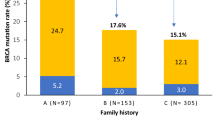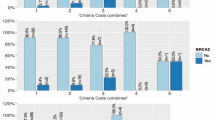Abstract
The contribution of BRCA1 and BRCA2 to breast cancer incidence in Brazil has not yet been explored. In order to estimate the proportion of breast cancers due to BRCA1 and BRCA2 mutations in Brazil, we conducted a study of unselected breast cancer patients from Rio de Janeiro, Brazil. We enrolled 402 women with breast cancer from a large public hospital and two private medical clinics in the city. A detailed family history was obtained from each patient and a blood sample was obtained for DNA analysis. Mutations in BRCA1 and BRCA2 were sought using a combination of techniques, but all mutations were confirmed by direct sequencing. Overall, nine mutations were identified (six in BRCA1 and three in BRCA2) representing 2.3% of the total. The most common mutation, 5382insC in BRCA1, was seen five times and accounted for 56% of all identified mutations. A second mutation, in BRCA2 (6633del5) was seen in two unrelated women. In summary, BRCA1 and BRCA2 mutations are not uncommon in Brazilian women with breast cancer. It appears that a small number of founder mutations may be predominant. Moreover, a small number of founder mutations may be prevalent in Brazil, raising the possibility that a rapid and inexpensive genetic test may be developed to screen for inherited susceptibility to breast cancer in Brazil.
Similar content being viewed by others
References
Narod S, Ford D, Devilee P et al (1995) Genetic heterogeneity of breast–ovarian cancer revisited. Am J Hum Genet 57:957–958
Koifman RJ, Koifman S, Vieria RJS (1998) Familial aggregation of breast/ovarian cancer age of onset along subsequent generations in Brazil. Cad Saude Publica 14(Suppl 3):181–185
Ford D, Easton DF, Bishop DT et al (1994) Risks of cancer in BRCA1-mutation carriers. Lancet 343:692–695
Thompson D, Easton D, Breast Cancer Linkage Consortium (2001) Variation in cancer risks by mutation position in BRCA2 mutation carriers. Am J Hum Genet 68:410–419
Thompson D, Easton D, the Breast Cancer Linkage Consortium (2002) Variation in BRCA1 cancer risks by mutation position. Cancer Epidemiol Biomarkers Prev 11:329–336
King M-C, Marks JH, Mandell JB et al (2003) Breast and ovarian cancer risks dud to inherited mutations in BRCA1 and BRCA2. Science 302:643–646
Antoniou A, Pharoah PDP, Narod S et al (2003) Average risks of breast and ovarian cancer associated with BRCA1 and BRCA2 mutations detected in case series unselected for family history: a combined analysis of 22 studies. Am J Hum Genet 72:1117–1130
Narod SA, Foulkes WD (2004) BRCA1 and BRCA2: 1994 and beyond. Nat Rev Cancer 4:665–676
Kuperstein G, Foulkes WD, Ghadirian P et al (2000) A rapid fluorescent multiplexed-PCR analysis (FMPA) for founder mutations in the BRCA1 and BRCA2 genes. Clin Genet 57:213–220
The BRCA1 Exon 13 Duplication Screening Group (2000) The exon 13 duplication in the BRCA1 gene is a founder mutation present in geographically diverse populations. Am J Hum Genet 67:207–212
Kuperstein G, Jack E, Risch H et al (2006) A fluorescent multiplexed-DGGE (FMD) screening test for BRCA1 gene. Genet Test 10:1–7
Gross E, Arnold N, Pfeifer K et al (2000) Identification of specific BRCA1 and BRCA2 variants by DHPLC. Hum Mutat 16:345–353
Ford D, Easton DF, Bishop DT et al (1994) Risks of cancer in BRCA1-mutation carriers. Lancet 343:692–695
Thompson D, Easton D, the Breast Cancer Linkage Consortium (2001) Variation in cancer risks by mutation position in BRCA2 mutation carriers. Am J Hum Genet 68:410–419
Thompson D, Easton D, the Breast Cancer Linkage Consortium (2002) Variation in BRCA1 cancer risks by mutation position. Cancer Epidemiol Biomarkers Prev 11:329–336
King M-C, Marks JH, Mandell JB et al (2003) Breast and ovarian cancer risks due to inherited mutations in BRCA1 and BRCA2. Science 302:643–646
Dufloth RM, Carvalho S, Heinrich JK et al (2005) Analysis of BRCA1 and BRCA2 mutations in Brazilian breast cancer patients with positive family history. Sao Paulo Med J 123:192–197
Tonin P, Weber B, Offit K et al (1996) Frequency of recurrent BRCA1 and BRCA2 mutations in Ashkenazi Jewish breast cancer families. Nat Med 2:1179–1183
Gorski B, Byrski T, Huzarski T et al (2000) Founder mutations in BRCA1 gene in Polish families with breast–ovarian cancer. Am J Hum Genet 66:1963–1968
Carvalho-Silva DR, Santos FR, Rocha J et al (2001) The phylogeography of Brazilian Y-chromosome lineages. Hum Genet 68:281–286
Jara L, Ampuero S, Santibanez E et al (2006) BRCA1 and BRCA2 mutations in a South American population. Cancer Cenet Cytogenet 166:36–45
Gallardo M, Silva A, Rubio L et al (2006) Incidence of BRCA1 and BRCA2 mutations in 54 Chilean families with breast/ovarian cancer, genotype–phenotype correlations. Breast Cancer Res Treat 95:81–87
Risch HA, McLaughlin JR, Cole DEC et al (2001) Prevalance and penetrance of germline BRCA1 and BRCA1 mutations in a population series of 649 women with ovarian cancer. Am J Hum Genet 68:700–710
Unger MA, Nathanson KL, Calzone K et al (2000) Screening for genomic rearrangements in families with breast and ovarian cancer identifies BRCA1 mutations previously missed by conformation-sensitive gel electrophoresis or sequencing. Am J Hum Genet 67:841–850
Acknowledgments
The authors would like to acknowledge support in the form of research grants from the Canadian Breast Cancer Research Alliance (CBCRA), and the Union International Centre le Cancer. Dr. Magda Gomes is also the recipient of an International Cancer Technology Transfer (ICRETT) Fellowship from the International Union Against Cancer (UICC).
Author information
Authors and Affiliations
Corresponding author
Additional information
All studies listed in this paper are in accordance with the ethical standards of the regional hospitals in the listed study area.
Rights and permissions
About this article
Cite this article
Gomes, M.C.B., Costa, M.M., Borojevic, R. et al. Prevalence of BRCA1 and BRCA2 mutations in breast cancer patients from Brazil. Breast Cancer Res Treat 103, 349–353 (2007). https://doi.org/10.1007/s10549-006-9378-6
Received:
Accepted:
Published:
Issue Date:
DOI: https://doi.org/10.1007/s10549-006-9378-6




